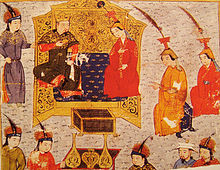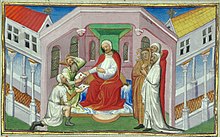Sorghaghtani Beki: Difference between revisions
No edit summary |
+image |
||
| Line 1: | Line 1: | ||
{{redirect|Beki|the musician|Beki Bondage}} |
{{redirect|Beki|the musician|Beki Bondage}} |
||
[[Image: |
[[Image:TuluiWithQueenSorgaqtani.jpg|thumb|Sorghaghtani with her husband, the Khan [[Tului]]. [[Rashid al-Din]], early 14th century.]] |
||
'''Sorghaghtani Beki''' or '''Sorkhokhtani''' or '''Sorkhogtani bekhi''' (bekhi is a title) (died [[1252]]), a [[Kereyid]] princess of the [[Nestorian Christian]] faith and daughter-in-law of [[Genghis Khan]], was one of the most powerful and competent women in the [[Mongol Empire]]. Married to [[Tolui]], Genghis' youngest son, she raised her sons to be leaders, and maneuvered the family politics so that all four of her sons |
'''Sorghaghtani Beki''' or '''Sorkhokhtani''' or '''Sorkhogtani bekhi''' (bekhi is a title) (died [[1252]]), a [[Kereyid]] princess of the [[Nestorian Christian]] faith and daughter-in-law of [[Genghis Khan]], was one of the most powerful and competent women in the [[Mongol Empire]]. Married to [[Tolui]], Genghis' youngest son, she raised her sons to be leaders, and maneuvered the family politics so that all four of her sons |
||
were to become [[Great Khan]]s, founding several dynasties: |
were to become [[Great Khan]]s, founding several dynasties: |
||
| Line 29: | Line 29: | ||
==Life== |
==Life== |
||
[[Image:WangKhan.JPG|thumb|Sorghaghtani Beki was the niece of the Nestorian [[Kerait]] ruler [[Wang Khan|Wang Khan "Toghrul"]], known as "[[Prester John]]". "Le Livre des Merveilles", 15th century.]] |
|||
Sorkhokhtani was the niece of [[Kereyid]] leader the [[Wang Khan|Wang Khan "Toghrul"]]. His brother Jakha Gambu was a warlord with the [[Tangut]] but joined forces with Genghis at some point in the late 1190s. |
Sorkhokhtani was the niece of [[Kereyid]] leader the [[Wang Khan|Wang Khan "Toghrul"]]. His brother Jakha Gambu was a warlord with the [[Tangut]] but joined forces with Genghis at some point in the late 1190s. |
||
Revision as of 20:56, 28 February 2008

Sorghaghtani Beki or Sorkhokhtani or Sorkhogtani bekhi (bekhi is a title) (died 1252), a Kereyid princess of the Nestorian Christian faith and daughter-in-law of Genghis Khan, was one of the most powerful and competent women in the Mongol Empire. Married to Tolui, Genghis' youngest son, she raised her sons to be leaders, and maneuvered the family politics so that all four of her sons were to become Great Khans, founding several dynasties:
- Möngke Khan: 1251-1259
- Kublai Khan: 1259-1294, Eastern Mongol Empire, Yuan dynasty
- Hulagu Khan: 1262-1265, Ilkhanate dynasty, (Central Asia)
- Ariq Boke, her fourth son, was also declared Great Khan (rivalling Kublai) for a short period in 1260; he would eventually be captured by Kublai in 1264.
She is spoken of very highly both in the Secret History, as well as by Muslim, Chinese and Christian historians.
- “If I were to see among the race of women another woman like this, I should say that the race of women was far superior to that of men” (Syriac scholar Bar Hebraeus)[1][2]
As a moving spirit behind the Mongol Empire, she is responsible for much of the trade openings and intellectual exchange made possible by this, the largest contiguous empire in world history. As such, she may count among the most influential women in world history[1].
Life

Sorkhokhtani was the niece of Kereyid leader the Wang Khan "Toghrul". His brother Jakha Gambu was a warlord with the Tangut but joined forces with Genghis at some point in the late 1190s.
According to the Secret History of the Mongols, around 1203, when Wang Khan (also spelled Ong Khan) was a more powerful leader than Temüjin (name at birth of Genghis), Temüjin proposed to Toghrul that his eldest son Jochi might marry Toghrul's daughter, thus binding the two groups. However, Toghrul refused this alliance, and later attempted to kill the increasingly powerful Temüjin through an invitation to discuss this proposal. However, Temüjin discovered this plan and they escaped at the last moment. Eventually, the Kereyids were routed in the ensuing war and Ong Khan was possibly killed by the Naimans.
After the Kereyid defeat, Jakha Gambu however, remained loyal to Genghis. At some point thereafter, Genghis himself married one of his daughters (later handed over to another general), and gave his younger daughter Sorkhokhtani to his teenage son Tolui[3], with whom she eventually had five children, four sons and a daughter.
Like most Mongol women of the time, Sorkhokhtani wielded great authority at home. Women had far more rights in Mongolia than in China, Europe, or other cultures at the time, especially since the men were often away and they were the ones responsible for the home[2].
After Ogedei Khan became the Khan, the Secret History suggests that he may have consulted Sorkhokhtani on various matters, and he always held her in high regard[4].
Tolui, whose kingdom included eastern Mongolia and Northern China, died after a drinking binge at the age of 40[1], and Sorkhokhtani became the regent. Ogodei sought to link her realm to his and proposed that she marry his son Güyük (widows often married again within the family among Mongols), but she refused, claiming that her four sons needed her attention, but possibly because she wished to retain the kingdom for her sons.
At this time, she probably had about 13,000 soldiers under her command.
Regency
Although she herself was illiterate, she recognized the value of literacy in running such a far-flung empire. Each of her sons learned a different language for different regions.
Nominally a Nestorian Christian, like other Mongols, she respected other religions. and did not view religion as her primary identity. Her sons, like Genthis, were all very liberal minded in matters of religion, and the Mongol empire promulgated the notion of state above religion, while supporting all major religions of the time[1].
After Ogedei Khan's death in 1241, his wife Töregene Khatun ruled as regent until 1246, when she managed to get her son Güyük elected as the Great Khan at a small kurultai (Mongol congress). However, he immediately set out to undermine his mother's power, as well as that of Sorokhkhani and Ebuskun (the wife of Chaghatai Khan, regent for the Central Asian Empire).
Meanwhile, these machinations had alienated the rest of the family and Sorokhkhani had secretly teamed up with Guyuk's cousin Batu Khan, the senior male in the family and ruler of the Golden Horde (north of Caspian Sea to Kiev). In 1248, when Güyük was setting out on a campaign to Europe (ostensibly for conquest, but possibly to defeat Batu Khan), he died under somewhat suspicious circumstances; some have speculated that Sorokhkhani may have taken "direct action against Guyuk"[1].
After Güyük's death, Batu and Sorkhokhtani championed the name of Möngke, who had fought along with Batu in the European campaign, Sorkhokhtani's eldest son, as Great Khan. Mongke was named Great Khan at a kurultai organized by Batu in Siberia in 1250, but this was protested as not being in Mongolia proper. However, the ancient Mongol homeland of where Genghis had been born was in her regency, so she organized a kurultai here which was attended by Batu's brother Berke, where Mongke was formally named the Great Khan. The Ogedei and Guyuk families attempted to assassinate him, but failed, and Mongke arrested and drowned Guyuk's widow Oghul Ghaimish, and many other members of Ogedei's family.
Sorkhokhtani died in February 1252 around the Mongol New Year festival, a few months after Mongke's accession ceremony. She was given the title of “empress” in 1310 in a ceremony that included a Nestorian mass.
References
- ^ a b c d e
Jack Weatherford (2004). Genghis Khan and the making of the modern world. Three Rivers Press. ISBN 978-0-609-61062-6 (0-609-61062-7).
{{cite book}}: Check|isbn=value: invalid character (help) - ^ a b Morris Rossabi. "Women of the Mongol Court".These edited notes were taken from a lecture by Morris Rossabi, presented as part of the lecture series in conjunction with Mongolia: The Legacy of Chinggis Khan, an exhibition at the Denver Art Museum. Cite error: The named reference "rossabi" was defined multiple times with different content (see the help page).
- ^ John Man (2006). Kublai Khan. Bantam Press.
- ^ Per Inge Oestmoen (January 2001). "Women in Mongol society: The characteristics and roles of females among the Mongols".
Other References
- Davis-Kimball, Jeannine.(2002) Warrior Women, An Archealogist's Search for History's Hidden Heroines. Warner Books, Inc. Page 223-226. ISBN 0-446-52546-4
